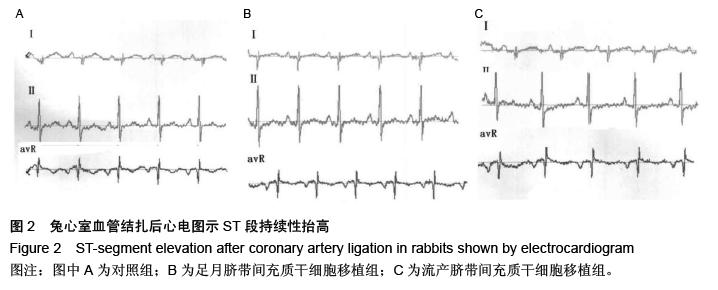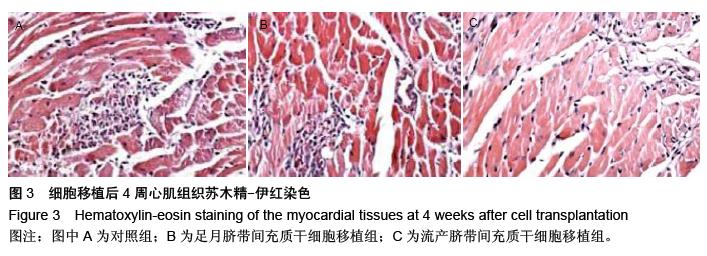| [1] Soonpaa MH, Koh GY, Klug MG,et al.Formation of nascent intercalated disks between grafted fetal cardiomyocytes and host myocardium.Science. 1994 Apr 1;264(5155):98-101.
[2] Orlic D, Kajstura J, Chimenti S,et al.Bone marrow cells regenerate infarcted myocardium.Nature. 2001;410 (6829):701-705.
[3] Kamdar F, Jameel MN, Score P, et al. Cellular therapy promotes endogenous stem cell repair.Can J Physiol Pharmacol. 2012;90(10):1335-1344.
[4] Mohsin S, Khan M, Toko H,et al.Human cardiac progenitor cells engineered with Pim-I kinase enhance myocardial repair.J Am Coll Cardiol. 2012;60(14): 1278-1287.
[5] Bolli R, Tang XL, Sanganalmath SK,et al.Intracoronary delivery of autologous cardiac stem cells improves cardiac function in a porcine model of chronic ischemic cardiomyopathy.Circulation. 2013;128(2):122-131.
[6] 牛红星,穆军升,张健群,等.骨髓间充质干细胞向心肌分化的实验研究[J].心肺血管病杂志,2013,32(3): 357-360.
[7] 张颖,李娜,辛毅,等.大鼠静脉注射人脐带胶样组织来源间充质干细胞的安全性研究[J].心肺血管病杂志,2013,32 (6):783-788.
[8] 李娜,辛毅,林筝,等.多次移植人脐带间充质干细胞对大鼠Th1和Th2比值的影响[J].心肺血管病杂志,2013,32(6): 789-793.
[9] Strauer BE, Brehm M, Zeus T, et al. Intracoronary, human autologous stem cell transplantation for myocardial regeneration following myocardial infarction. Dtsch Med Wochenschr. 2001;126(34-35):932-938.
[10] Assmus B, Schächinger V, Teupe C, et al. Transplantation of Progenitor Cells and Regeneration Enhancement in Acute Myocardial Infarction (TOPCARE-AMI). Circulation. 2002;106(24):3009-3017.
[11] Stamm C, Westphal B, Kleine HD, et al. Autologous bone-marrow stem-cell transplantation for myocardial regeneration. Lancet. 2003;361(9351):45-46.
[12] Wollert KC, Meyer GP, Lotz J, et al. Intracoronary autologous bone-marrow cell transfer after myocardial infarction: the BOOST randomised controlled clinical trial. Lancet. 2004;364(9429):141-148.
[13] Donndorf P, Kundt G, Kaminski A, et al. Intramyocardial bone marrow stem cell transplantation during coronary artery bypass surgery: a meta-analysis. J Thorac Cardiovasc Surg. 2011;142(4):911-920.
[14] Chugh AR, Beache GM, Loughran JH, et al. Administration of cardiac stem cells in patients with ischemic cardiomyopathy: the SCIPIO trial: surgical aspects and interim analysis of myocardial function and viability by magnetic resonance. Circulation. 2012;126(11 Suppl 1):S54-64.
[15] Bartunek J, Behfar A, Dolatabadi D, et al. Cardiopoietic stem cell therapy in heart failure: the C-CURE (Cardiopoietic stem Cell therapy in heart failURE) multicenter randomized trial with lineage-specified biologics. J Am Coll Cardiol. 2013;61(23):2329-2338.
[16] Fisher SA, Dorée C, Brunskill SJ, et al. Bone Marrow Stem Cell Treatment for Ischemic Heart Disease in Patients with No Option of Revascularization: A Systematic Review and Meta-Analysis. PLoS One. 2013;8(6):e64669.
[17] Kandala J, Upadhyay GA, Pokushalov E, et al. Meta-analysis of stem cell therapy in chronic ischemic cardiomyopathy. Am J Cardiol. 2013;112(2):217-225.
[18] 姚艳,杜昕,马长生.骨髓间充质干细胞治疗缺血性心脏病的机制和应用[J].心肺血管病杂志,2014,33(3):460-463.
[19] 李娜,孔晴宇,辛毅,等.间充质干细胞治疗心肌缺血性疾病的临床研究进展[J].心肺血管病杂志,2013,32(3):377- 379.
[20] Friedenstein AJ, Petrakova KV, Kurolesova AI, et al. Heterotopic of bone marrow. Analysis of precursor cells for osteogenic and hematopoietic tissues. Transplantation. 1968;6(2):230-247.
[21] Awad HA, Butler DL, Boivin GP, et al. Autologous mesenchymal stem cell-mediated repair of tendon. Tissue Eng. 1999;5(3):267-277.
[22] Dominici M, Le Blanc K, Mueller I, et al. Minimal criteria for defining multipotent mesenchymal stromal cells. The International Society for Cellular Therapy position statement. Cytotherapy. 2006;8(4):315-317.
[23] 郭子宽.间充质干细胞及其临床应用中的几个问题[J].中国组织工程研究,2012,16(1):1-10.
[24] 牟乐明,孙占胜,王伯珉,等.骨髓间充质干细胞移植对脊髓损伤大鼠Toll样受体4表达的影响[J].山东大学学报:医学版.2014,52(1):37-41.
[25] Nagaya N, Kangawa K, Itoh T, et al. Transplantation of mesenchymal stem cells improves cardiac function in a rat model of dilated cardiomyopathy. Circulation. 2005;112(8):1128-1135.
[26] 王建安,谢小洁,何红,等.骨髓间质干细胞移植治疗原发性扩张型心肌病的疗效与安全性[J].中华心血管病杂志, 2006,34(2):107-110.
[27] Yang CC, Shih YH, Ko MH, et al. Transplantation of human umbilical mesenchymal stem cells from Wharton's jelly after complete transection of the rat spinal cord. PLoS One. 2008;3(10):e3336.
[28] Tsai PC, Fu TW, Chen YM, et al. The therapeutic potential of human umbilical mesenchymal stem cells from Wharton's jelly in the treatment of rat liver fibrosis. Liver Transpl. 2009;15(5):484-495.
[29] Bartholomew A, Sturgeon C, Siatskas M, et al. Mesenchymal stem cells suppress lymphocyte proliferation in vitro and prolong skin graft survival in vivo. Exp Hematol. 2002;30(1):42-48.
[30] Di Nicola M, Carlo-Stella C, Magni M, et al. Human bone marrow stromal cells suppress T-lymphocyte proliferation induced by cellular or nonspecific mitogenic stimuli. Blood. 2002;99(10):3838-3843.
[31] Glennie S, Soeiro I, Dyson PJ, et al. Bone marrow mesenchymal stem cells induce division arrest anergy of activated T cells. Blood. 2005;105(7): 2821-2827.
[32] Le Blanc K. Immunomodulatory effects of fetal and adult mesenchymal stem cells. Cytotherapy. 2003; 5(6):485-489.
[33] Xiong Q, Ye L, Zhang P, et al. Functional consequences of human induced pluripotent stem cell therapy: myocardial ATP turnover rate in the in vivo swine heart with postinfarction remodeling. Circulation. 2013;127(9):997-1008.
[34] Malliaras K, Zhang Y, Seinfeld J, et al. Cardiomyocyte proliferation and progenitor cell recruitment underlie therapeutic regeneration after myocardial infarction in the adult mouse heart. EMBO Mol Med. 2013;5(2): 191-209.
[35] Lila N, Amrein C, Guillemain R, et al. Human leukocyte antigen-G expression after heart transplantation is associated with a reduced incidence of rejection. Circulation. 2002;105(16):1949-1954.
[36] Marchal-Bras-Goncalves R, Rouas-Freiss N, Connan F, et al. A soluble HLA-G protein that inhibits natural killer cell-mediated cytotoxicity. Transplant Proc. 2001; 33(3):2355-2359.
[37] Horuzsko A, Lenfant F, Munn DH, et al. Maturation of antigen-presenting cells is compromised in HLA-G transgenic mice. Int Immunol. 2001;13(3):385-394.
[38] Ristich V, Liang S, Zhang W, et al. Tolerization of dendritic cells by HLA-G. Eur J Immunol. 2005;35(4): 1133-1142.
[39] Liang S, Baibakov B, Horuzsko A. HLA-G inhibits the functions of murine dendritic cells via the PIR-B immune inhibitory receptor. Eur J Immunol. 2002;32(9): 2418-2426.
[40] Kanai T, Fujii T, Unno N, et al. Human leukocyte antigen-G-expressing cells differently modulate the release of cytokines from mononuclear cells present in the decidua versus peripheral blood. Am J Reprod Immunol. 2001;45(2):94-99.
[41] Lila N, Carpentier A, Amrein C, et al. Implication of HLA-G molecule in heart-graft acceptance .Lancet. 2000;355(9221):2138.
[42] Qiu J, Terasaki PI, Miller J, et al. Soluble HLA-G expression and renal graft acceptance. Am J Transplant. 2006;6(9):2152-2156.
[43] Luque J, Torres MI, Aumente MD, et al. Soluble HLA-G in heart transplantation: their relationship to rejection episodes and immunosuppressive therapy. Hum Immunol. 2006;67(4-5):257-263. |
.jpg)


